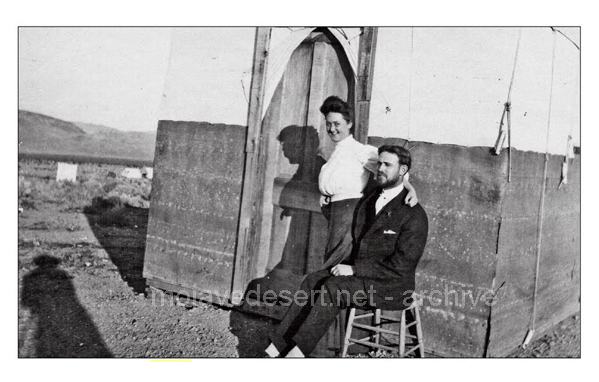Greenwater
Early in 1904, Aurthur Kunze reportedly found copper float, and in December, 1904, Fred Birney and Phil Creasor discovered more of it, in a location southwest of Death Valley Junction. When Kunze sold his claims to Charles Schwab at Goldfield, Nevada in July, 1906, it triggered a rush. The stampede to Greenwater was on!Greenwater was the name of the townsite Kunze established near his claims. It takes it's name from Greenwater Spring south of town. Harry Ramsey laid out the townsite of Copperfield two miles to the east of Greenwater townsite. A third townsite (Furnace) was laid out near Patsy Clark's Furnace Creek copper mine. In September, 1906, the Tonopah Lumber Company reported it had sold 150,000 feet of lumber to the Greenwater camps and mines, and a hundred men were in the area.
Kunze moved his townsite into Copperfield and the two became known as Greenwater by December, 1906. In early 1907, the population reached 700. By April the telephone line from Rhyolite reached Greenwater. Water sold for high prices, $15 a barrel, or one dollar a gallon. In May 1907 Kunze traveled to Los Angeles to order a printing press and supplies for the Death Valley Chuck-Walla and the Green water Miner. In June, 1907, the press building at Greenwater burned to the ground. The new press was never shipped in. The Ash Meadows Water Company started laying a 27 mile, 6 inch pipeline from Ash Meadows Spring. After spending $200,000 the line was 10 miles long. It was never completed.

A happy couple in Greenwater
Upwards of 30 companies were formed, with capitalizations from one to five million dollars each, allegedly to tap Greenwater's riches. The Furnace Creek Copper Company, capitalized with a million shares offered originally at 25 cents each, was soon selling at over $5 a share. The public, encouraged by the big names promoting Greenwater, bought any stock with Greenwater in its name. New stock promotions were sure to include the name Greenwater somewhere in their corporate title. The South Greenwater Copper Company was typical of the many companies that solicited public support. Their advertising copy read, "We are reasonably sure that we have a mine at South Greenwater. We would not spend money there if we were not." Charles Schwab, Augustus Heinze, T. L. Oddie and F. M. (Borax) Smith were all "reasonably sure" they had a mine, too, for they were spending money on Greenwater. But no one had a paying mine at Greenwater. Over 2,500 claims blanketed the acreage. Greenwater had a telegraph and a telephone line, two newspapers, a $100,000 bank, a drug store, boardinghouse, and several saloons. But not for long.
Pope Yeatman, a mining engineer hired by the Guggenheim interests, came to Greenwater to investigate the Furnace Creek copper mine, Greenwater's biggest. By then it was some 200 feet deep. The mine had opened up on a body of copper oxides, and some 20 tons had been shipped in early 1906 that yielded 20 percent copper. Yeatman took one look and immediately left camp. Making a long distance phone call to New York, his observations that day marked the beginning of the end for Greenwater. The ore body in the Furnace Creek copper mine went nowhere, and the shaft had hit what appeared to be volcanic ash. With this news the Greenwater copper market collapsed.
On September 7, 1907, the Beatty Bullfrog Miner reported that the Green water Miner had stopped publication and that a hundred people were still at Greenwater. Buildings were brought down one by one, many of them being hauled to Zabriskie or Shoshone. The Greenwater Copper Company hung around until January 8, 1910, when it gave up on Greenwater after sinking a 1,400-foot shaft and finding only low grade ore.
It is interesting to note that the Amalgamated Copper Company, in control of over 50 percent of the nation's copper production in the l900s, began stockpiling copper in April 1907. This was when Greenwater was at its height. In September, when the myth of Greenwater was exposed, the copper was unloaded on the market, knocking down the price of copper and copper mining shares.. Augustus Heinze, who allegedly bought claims in Greenwater for $200,000, tried to keep the price of copper up by using funds from several banks he controlled. His efforts resulted in the bank panic of 1907. George Graham Rice estimated that $30,000,000 was invested in Greenwater in four short months.